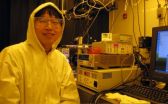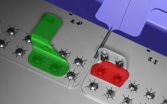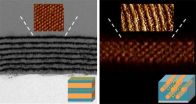(Press-News.org) This press release is available in German.
In particle physics, the baryon family refers to particles that are made up of three quarks. Quarks form a group of six particles that differ in their masses and charges. The two lightest quarks, the so-called "up" and "down" quarks, form the two atomic components, protons and neutrons. All baryons that are composed of the three lightest quarks ("up", "down" and "strange" quarks) are known. Only very few baryons with heavy quarks have been observed to date. They can only be generated artificially in particle accelerators as they are heavy and very unstable.
In the course of proton collisions in the LHC at CERN, physicists Claude Amsler, Vincenzo Chiochia and Ernest Aguiló from the University of Zurich's Physics Institute managed to detect a baryon with one light and two heavy quarks. The particle Xi_b^* comprises one "up", one "strange" and one "bottom" quark (usb), is electrically neutral and has a spin of 3/2 (1.5). Its mass is comparable to that of a lithium atom. The new discovery means that two of the three baryons predicted in the usb composition by theory have now been observed.
The discovery was based on data gathered in the CMS detector, which the University of Zurich was involved in developing. The new particle cannot be detected directly as it is too unstable to be registered by the detector. However, Xi_b^* breaks up in a known cascade of decay products. Ernest Aguiló, a postdoctoral student from Professor Amsler's group, identified traces of the respective decay products in the measurement data and was able to reconstruct the decay cascades starting from Xi_b^* decays.
The calculations are based on data from proton-proton collisions at an energy of seven Tera electron volts (TeV) collected by the CMS detector between April and November 2011. A total of 21 Xi_b^* baryon decays were discovered – statistically sufficient to rule out a statistical fluctuation.
The discovery of the new particle confirms the theory of how quarks bind and therefore helps to understand the strong interaction, one of the four basic forces of physics which determines the structure of matter.
###
UZH and the LHC
The University of Zurich is involved in the LHC at CERN with three research groups. Professor Amsler's and Professor Chiochia's groups are working on the CMS experiment; Professor Straumann's group is involved in the LHCb experiment.
CMS detector
The CMS detector is designed to measure the energy and momentum of photons, electrons, muons and other charged particles with a high degree of accuracy. Various measuring instruments are arranged in layers in the 12,500-ton detector, with which traces of the particles resulting from the collisions can be recorded. 179 institutions worldwide were involved in developing CMS. In Switzerland, these are the University of Zurich, ETH Zurich and the Paul Scherrer Institute.
Researchers from the University of Zurich discover new particle at CERN
2012-04-30
ELSE PRESS RELEASES FROM THIS DATE:
Atomic clock comparison via data highways
2012-04-30
This press release is available in German.
Optical atomic clocks measure time with unprecedented accuracy. However, it is the ability to compare clocks with one another that makes them applicable for high-precision tests in fundamental theory, from cosmology all the way to quantum physics. A clock comparison, i.e. a comparison of their optical frequencies, proved to be challenging so far as the few existing optical clocks around the world are not readily portable due to their complex nature. A team of researchers from the Physikalisch-TechnischeBundesanstalt (PTB) in ...
Global prices of pollination-dependent products such as coffee could rise in the long term
2012-04-30
This press release is available in German.
Leipzig/Dresden/Freiburg. In recent years the economic value of pollination-dependent crops has substantially increased around the world. As a team of researchers from the Helmholtz Centre for Environmental Research (UFZ), the Technical University of Dresden and the University of Freiburg headed by the UFZ wrote in an article entitled "Spatial and temporal trends of global pollination benefit" in the open-access journal PLoS ONE the value of ecological pollination services was around 200 billion US dollars in 1993 and rose ...
New drug to tackle fat problems
2012-04-30
Medical researchers at the University of Sheffield have defined the structure of a key part of the human obesity receptor- an essential factor in the regulation of body fat- which could help provide new treatments for the complications of obesity and anorexia.
This major advance in research, published in the journal Structure, will greatly enhance the ability to generate drugs which can both block and stimulate the receptor for the obesity hormone leptin. This could have life-changing effects on people suffering from the complications of obesity and malnutrition.
Researchers ...
Blood samples show deadly frog fungus at work in the wild
2012-04-30
The fungal infection that killed a record number of amphibians worldwide leads to deadly dehydration in frogs in the wild, according to results of a new study.
High levels of an aquatic, chytrid fungus called Batrachochytrium dendrobatidis (Bd) disrupt fluid and electrolyte balance in wild frogs, the scientists say, severely depleting the frogs' sodium and potassium levels and causing cardiac arrest and death.
Their findings confirm what researchers have seen in carefully controlled lab experiments with the fungus, but San Francisco State University biologist Vance ...
Can nature's beauty lift citizens from poverty?
2012-04-30
Using nature's beauty as a tourist draw can boost conservation in China's valued panda preserves, but it isn't an automatic ticket out of poverty for the humans who live there, a unique long-term study shows.
Often those who benefit most from nature-based tourism are people who already have resources. The truly impoverished have a harder time breaking into the tourism business, according to the paper, "Drivers and Socioeconomic Impacts of Tourism Participation in Protected Areas," published in the April 25 edition of PLoS One.
The study looks at nearly a decade of burgeoning ...
Folding light: Wrinkles and twists boost power from solar panels
2012-04-30
Taking their cue from the humble leaf, researchers have used microscopic folds on the surface of photovoltaic material to significantly increase the power output of flexible, low-cost solar cells.
The team, led by scientists from Princeton University, reported online April 22 in the journal Nature Photonics that the folds resulted in a 47 percent increase in electricity generation. Yueh-Lin (Lynn) Loo, the principal investigator, said the finely calibrated folds on the surface of the panels channel light waves and increase the photovoltaic material's exposure to light.
"On ...
NYUCN's Dr. Laura Wagner: Study finds accreditation improves safety culture at nursing homes
2012-04-30
Accredited nursing homes report a stronger resident safety culture than nonaccredited facilities, according to a new study published in the May 2012 issue of The Joint Commission Journal on Quality and Patient Safety.
The study shows that senior managers at more than 4,000 facilities across the U.S. identify Joint Commission accreditation as a positive influence on patient safety issues such as staffing, teamwork, training, nonpunitive responses to mistakes, and communication openness. The findings that accreditation stimulates positive changes in safety-related organizational ...
Slow-growing babies more likely in normal-weight women; Less common in obese pregnancies
2012-04-30
Obesity during pregnancy puts women at higher risk of a multitude of challenges. But, according to a new study presented earlier this month at the American Institute of Ultrasound in Medicine annual convention, fetal growth restriction, or the poor growth of a baby while in the mother's womb, is not one of them. In fact, study authors from the University of Rochester Medical Center found that the incidence of fetal growth restriction was lower in obese women when compared to non-obese women.
Researchers, led by senior study author and high-risk pregnancy expert Loralei ...
Assembly errors quickly identified
2012-04-30
Today's cars are increasingly custom-built. One customer might want electric windows, heated door mirrors and steering-wheel-mounted stereo controls, while another is satisfied with the minimum basic equipment. The situation with aircraft is no different: each airline is looking for different interior finishes – and lighting, ventilation, seating and monitors are different from one company to the next. Yet the customer's freedom is the manufacturer's challenge: because individual parts and mountings have to be installed in different locations along the fuselage, automated ...
Golden potential for gold thin films
2012-04-30
Scientists with the Lawrence Berkeley National Laboratory (Berkeley Lab) and the University of California (UC) Berkeley have directed the first self-assembly of nanoparticles into device-ready materials. Through a relatively easy and inexpensive technique based on blending nanoparticles with block co-polymer supramolecules, the researchers produced multiple-layers of thin films from highly ordered one-, two- and three-dimensional arrays of gold nanoparticles. Thin films such as these have potential applications for a wide range of fields, including computer memory storage, ...






